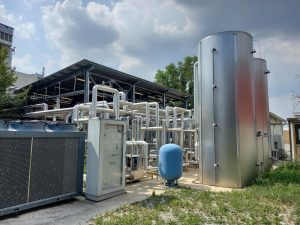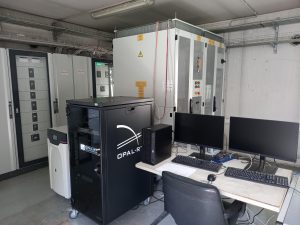RSE – MultiEnergy Test Facility
TA46 – RSE-METF
Location
Via Raffaele Rubattino 54
20134 Milan, Italy

Description
The MultiEnergy Test Facility is an experimental microgrid that allows for studies and experiments on innovative components and advanced control functions for smart grids, microgrids, and multi-energy systems that integrate vectors such as heat, electricity, and gas (hydrogen starting from 2026).
The laboratory covers an area of approximately 20,000 m2 and is made up of a low voltage electrical network which is connected and employs a dedicated 800 kVA transformer (23 kV/400 V) to the public electricity distribution network. Through the main distribution switchboard, it is possible to modify its topology, to represent different configurations of a distribution network (radial, ring, and mesh).
Different types of DER generators (photovoltaic (PV) fields, small wind turbine, natural gas ICE cogenerators), electrochemical storage systems (llithium-ion batteries, high-temperature nickel-sodium batteries, and supercapacitors), electrical and electronic loads, and EV charging stations are connected to the RSE microgrid. In addition, a multiterminal low voltage Direct Current (DC) microgrid, able to operate in islanded mode or be interconnected to the Alternating Current (AC) grid is installed in the same area. The system can operate in parallel to the main grid or islanded, resorting to a Master-Slave or a distributed configuration. A real-time simulator combined with a dedicated power amplifier is used to extend the test capability using a Hardware-in-the-Loop approach.
Most of the grid nodes, lines, and all the DERs are provided with electrical measure equipment (Power Quality Analyser and PMU), set up to collect and analyse the experimental data derived from the field test. An experimental distribution heat network is integrated into the existing electricity network. The purpose of the plant is the simulation and testing of a multi-energy system, in particular the integration of district heating networks with electricity and gas networks. The system is made up of heat generators, utilities, and the pipes and valves that make up the circuit configuration and distribution network.
The district heating network has a nominal capacity of approximately 200 kWth (corresponding to the maximum thermal power of the users). Heat generation can be managed by appropriately modulating the different generators according to the operating conditions required by the system. To integrate energy systems, the total thermal power of the generators is approximately 365 kWth. The maximum operating temperature is 95°C, while the nominal temperature, for experiments in existing district heating networks, is 80°C/60°C for the delivery and return lines respectively. The system can also operate at lower temperatures to emulate new-generation district heating networks.
Testing Capabilities
Studies and experiments on innovative components and advanced control functions for smart grids, microgrids, and multi-energy systems that integrate vectors such as heat, electricity, and gas.
Technical Equipment
The RI is made up of the following main components:
- Generation systems from renewable sources such as photovoltaic fields for a total nominal power of approximately 45 kWp, a 3 kWe small wind generator, and a small wind generator emulator consisting of a programmable asynchronous generator with 6 kW power; cogeneration plant with an internal combustion engine powered by natural gas with nominal power of 50 kWe/81 kWth and integrated with its thermal load emulator.
- Storage systems of different technologies such as a 32 kW/16 kWh Zebra battery, a 50 kW/67 kWh high-temperature sodium-nickel battery, and a 30 kW/lithium-Ion battery 30 kWh
- Programmable loads such as a 100 kW/70 kVAR three-phase resistive/inductive load, a 150kVAR capacitive load, a 6kW three-phase resistive load and a 12.6kW three-phase electronic load
- A DC distribution system network with two interface converters between AC network and DC network of 100 kVA and 50 kVA, 2 high temperature NaNiCl batteries (16 kWh, 30 kW for 30 s), 2 banks of supercapacitors (30 kW for 8 s) and 1 photovoltaic emulator (30 kW) connected via DC/DC converters, 1 programmable load of 30 kW directly connected to the direct current network and 1 load programmable 30 kW connected via DC/DC converter
- A power amplifier with a nominal power of 100 kVA usable to simulate different alternating current or direct current power supplies and interfaced via a RealTime OPAL-RT simulator which allows experiments in Control Hardware-in-the-Loop (CHIL) and Power Hardware-in-the-Loop (PHIL)
- A monitoring system consisting of network analysers (Janitza and Frer) on the different lines and the main components and synchronous and Phasor Measuring Instruments (PMU) installed in the main nodes of the network
- A Supervision and Data Acquisition System (SCADA) allows you to record and analyse data from the experimental activity, monitor power quality and electrical transients, and carry out control of the system
- The main components of the heat network are:
- A gas boiler with a nominal thermal power of 147 kWth
- 2 storage tanks with a volume of 10 m3
- A high-temperature water-to-water heat pump with 49 kWth thermal power
- A low-temperature water-to-water heat pump with 54 kWth thermal power
- An electric boiler with 50 kWth thermal power
- CHP with 50 kW electrical power and 81 kWth thermal power
- 4 thermal user emulators that can operate as a thermal load with thermal power of 50kWth or as local generators using 10kW electric heaters with the regulator
- Cooling circuit complete with circulation pump, heat exchangers, regulation valves and a chiller with 207 kWth cooling capacity used as a low-temperature source for the network components
Additional information
Technology Readiness Level: 4-6
Special considerations: See description
Technology clusters: Energy Storage, Information and Communication Technologies, Integrated Grids, PV
Website: https://www.rse-web.it/en/laboratories/low-voltage-distributed-generation-test-facility-laboratory/
Availability: All year
Provision of tools to prepare data sets in a FAIR way: No

